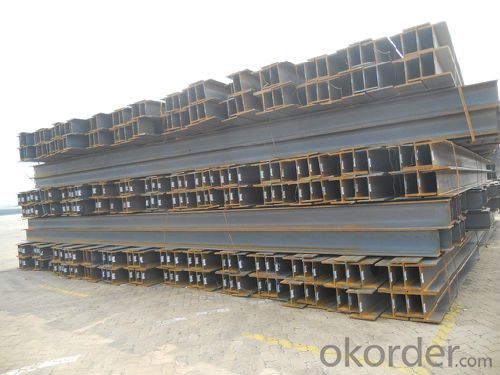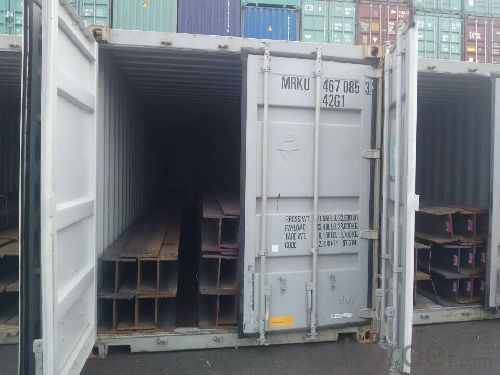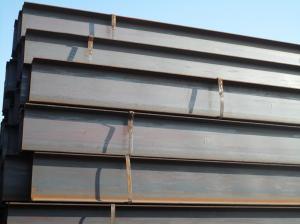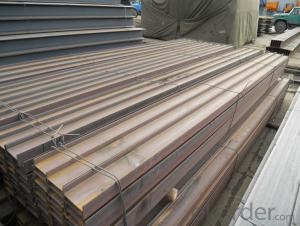Hot Rolled JIS Standard H Beams
- Loading Port:
- China Main Port
- Payment Terms:
- TT or LC
- Min Order Qty:
- 100 m.t.
- Supply Capability:
- 10000 m.t./month
OKorder Service Pledge
OKorder Financial Service
You Might Also Like
Product Description:
OKorder is offering Hot Rolled JIS Standard H Beams at great prices with worldwide shipping. Our supplier is a world-class manufacturer of steel, with our products utilized the world over. OKorder annually supplies products to African, South American and Asian markets. We provide quotations within 24 hours of receiving an inquiry and guarantee competitive prices.
Product Applications:
Hot Rolled JIS Standard H Beams are ideal for structural applications and are widely used inindustrial plants, civil construction, municipal works, oil platforms, bridges, flatbed beams, electrified railway power stand, railway bridges and other light steel structure, super-light H-beam is ideal for containers, mobile homes , all kinds of garage, box-type trains, electrical bracket, various venues, small villa manufacturing etc.
Product Advantages:
OKorder's Hot Rolled JIS Standard H Beams are durable, strong, and wide variety of sizes.
Main Product Features:
· Premium quality
· Prompt delivery & seaworthy packing (30 days after receiving deposit)
· Can be recycled and reused
· Mill test certification
· Professional Service
· Competitive pricing
Product Specifications:
Manufacture: Hot rolled
Grade: Q195 – 235
Certificates: ISO, SGS, BV, CIQ
Length: 12m, as per customer request
Packaging: Export packing, nude packing, bundled
Trademark | Rank | Chemical composition (quality score) % | |||||
C | Si | Mn | S | P | |||
≤ | ≤ | ≤ | |||||
Q235 | A | 0.14-0.22 | 0.30 | 0.30-0.65 | 0.050 | 0.045 | |
Q235 | B | 0.12-0.20 | 0.30 | 0.30-0.70 | 0.045 | 0.045 | |
Trademark | Rank | Pulling Test | |||||
Bend PointΔs/Mpa | Tensile Strength | Elongation Ratioδ5% | |||||
Thickness (Diameter) /MM | Thickness (Diameter) /MM | ||||||
≤16 | 16-40 | ≤16 | 16-40 | ||||
≥ | ≥ | ||||||
Q235 | A | 235 | 225 | 375-500 | 26 | 25 | |
Q235 | B | 235 | 225 | 375-500 | 26 | 25 | |
FAQ:
Q1: Why buy Materials & Equipment from OKorder.com?
A1: All products offered byOKorder.com are carefully selected from China's most reliable manufacturing enterprises. Through its ISO certifications, OKorder.com adheres to the highest standards and a commitment to supply chain safety and customer satisfaction.
Q2: How do we guarantee the quality of our products?
A2: We have established an advanced quality management system which conducts strict quality tests at every step, from raw materials to the final product. At the same time, we provide extensive follow-up service assurances as required.
Q3: How soon can we receive the product after purchase?
A3: Within three days of placing an order, we will arrange production. The normal sizes with the normal grade can be produced within one month. The specific shipping date is dependent upon international and government factors, the delivery to international main port about 45-60days.
Images:


- Q:300 * 150 * 6.5 * 9 H steel is used as steel beam, span 6 meters, spacing 2 meters, laying steel plate, 15 cm soil
- Q235 hot rolled H steel 300 x 150 x 6.5 x 9, weight per meter of 0.373KN. Wx=490000mm fand. Section modulus flexural strength design value of 215N/mm -. Uniform basic combination of load value Q, span 6m, the maximum bending moment design value of M=490000 * 215 =105350000N - M 105.35KN - m, q=105.35 * 8/6 L = 23.41KN/m.
- Q:What is the theoretical weight of welded H - section steel 900*350*20*30?
- H steel is mainly used in engineering, plant, equipment, machinery and equipment, bridges, highways, houses, etc., with good mechanical and physical properties, firm and energy-saving and environmental protection. H steel is an economical section steel, widely used in industry, construction, bridge, oil drilling and so on
- Q:What are the different types of steel H-beam profiles available?
- There exists a variety of steel H-beam profiles, each possessing their own distinct characteristics and applications. Here are several commonly encountered types: 1. W-beams, also known as wide flange beams, are characterized by their broader flange and are frequently employed in construction projects necessitating substantial support. These beams are renowned for their stability and resistance against bending. 2. S-beams, or American standard beams, possess a narrower flange when compared to W-beams and are often utilized in lighter structural endeavors. They offer a more cost-effective and manageable alternative to W-beams. 3. J-beams, also referred to as junior beams, feature a lighter weight and smaller profile in comparison to W-beams and standard beams. They are commonly employed in residential construction or smaller-scale projects. 4. HEB, HEM, and IPE beams, adhering to European standards, are extensively deployed in construction undertakings throughout Europe. HEB beams possess a wide flange, while HEM beams boast a wide flange and higher moment of inertia. IPE beams, characterized by a narrower flange, are often found in residential buildings. 5. JIS beams, conforming to Japanese industrial standards, are widely employed in construction ventures within Japan and other Asian nations. They are available in various sizes and profiles, including H, HP, and B series. 6. UB beams, also known as universal beams, feature a wide flange and are frequently utilized in construction projects necessitating versatility and strength. They are commonly found in bridges, buildings, and other structural applications. 7. Tapered beams possess a flange that gradually narrows, enabling better weight distribution and load-bearing capacity. They are frequently employed in roof trusses, bridges, and other scenarios where weight reduction is crucial. These aforementioned examples represent merely a selection of the diverse steel H-beam profiles available. The choice of profile hinges upon specific project requirements, including load-bearing capacity, span, and cost-effectiveness. Consulting a structural engineer or steel supplier can assist in determining the most suitable profile for a given application.
- Q:Are steel H-beams suitable for structures with irregular shapes?
- Steel H-beams are typically used as structural elements in buildings and bridges due to their strength and versatility. However, when it comes to structures with irregular shapes, the suitability of steel H-beams depends on the specific design requirements and constraints. In general, steel H-beams are a suitable choice for structures with irregular shapes as they offer high structural integrity and load-bearing capacity. They can be used to create complex frameworks and support systems that can accommodate various shapes and configurations. The flexibility of steel allows for customization and adaptation to different architectural designs. That being said, the design and construction of structures with irregular shapes often require careful planning and engineering. The irregularity of the shape may require additional support or reinforcement to ensure structural stability. This can be achieved by combining the H-beams with other structural elements, such as braces or trusses, to distribute the load effectively. It is important to consult with professional engineers and architects who specialize in structural design to assess the suitability of steel H-beams for a specific irregular-shaped structure. They can provide valuable insights and calculations to ensure that the H-beams are appropriately sized and positioned to meet the structural requirements and maintain the safety of the overall structure. In summary, steel H-beams can be suitable for structures with irregular shapes, but their application requires careful consideration of the specific design constraints and the expertise of professionals in the field of structural engineering.
- Q:How do steel H-beams perform in coastal environments?
- Due to their high resistance to corrosion, steel H-beams are well-suited for use in coastal environments. Typically, the steel used in H-beams is either galvanized or coated with protective materials to prevent rust and deterioration caused by exposure to saltwater, humidity, and other corrosive elements found in coastal areas. This protective coating ensures the longevity and structural integrity of the H-beams, making them suitable for various applications such as bridges, piers, and buildings in coastal regions. Furthermore, the strong and sturdy design of H-beams allows them to bear heavy loads and withstand strong winds commonly encountered in coastal areas. In summary, steel H-beams are a dependable and long-lasting choice for construction projects in coastal environments.
- Q:Can steel H-beams be used in railway overpasses?
- Yes, steel H-beams can be used in railway overpasses. They are commonly used in the construction of railway bridges and overpasses due to their high load-bearing capacity and structural strength.
- Q:How are steel H-beams connected or joined together in construction?
- Steel H-beams, also known as I-beams, find wide application in construction due to their strength and load-bearing capabilities. The connection or joining of these beams is accomplished using various techniques, depending on the specific construction project and its requirements. Welding stands as one of the most prevalent methods for joining steel H-beams. This technique involves heating the two beams at the connection point and subsequently fusing them together using a welding electrode. This results in a robust and enduring bond between the beams. Welding is extensively utilized in construction because it ensures a reliable and sturdy connection, thereby guaranteeing the structural integrity of the building. Bolting serves as another method employed to connect steel H-beams. It entails the use of bolts, nuts, and washers to secure the beams together at the connection point. Holes are drilled through the beams, and bolts are inserted and tightened using a wrench or spanner. Bolting is a popular choice as it allows for easy disassembly and reassembly, making it suitable for projects that may necessitate modifications or relocation in the future. In certain instances, steel H-beams can also be connected using rivets. Riveting involves the drilling of holes through both beams and subsequently inserting cylindrical metal pins known as rivets. These rivets are then hammered or compressed to securely fasten the beams together. Although riveting was extensively employed in the past, it has become less prevalent in modern construction due to the time-consuming nature of the process. Nevertheless, it can still be utilized in specific situations where the desire for aesthetically pleasing or historically significant riveted connections exists. Lastly, adhesive bonding can also be utilized to connect steel H-beams. This method entails the application of a strong adhesive or epoxy to the connection point, followed by the pressing of the beams together. Adhesive bonding offers the advantage of providing a clean and visually appealing connection without the need for visible welds or bolts. However, it is less commonly employed in construction due to the potential challenges involved in achieving a reliable and enduring bond. In conclusion, steel H-beams can be connected or joined together in construction through methods like welding, bolting, riveting, or adhesive bonding. The selection of the joining method depends on the specific project requirements, structural considerations, and aesthetic preferences.
- Q:What are the considerations when transporting or handling Steel H-Beams?
- When transporting or handling Steel H-Beams, there are several key considerations to keep in mind. Firstly, it is important to ensure the beams are securely fastened and properly balanced during transportation to prevent any shifting or tipping. Additionally, the beams should be protected against damage from impacts, vibrations, and adverse weather conditions by using appropriate packaging or covering them with suitable materials. It is crucial to use the correct lifting equipment and techniques to avoid overloading or damaging the H-Beams. Furthermore, the personnel involved in the transportation and handling process should be adequately trained and equipped with personal protective equipment to ensure their safety. Regular inspections and maintenance of the equipment used for transportation are also necessary to minimize any potential risks and ensure the integrity of the H-Beams.
- Q:What are the common welding techniques used for steel H-beams?
- The common welding techniques used for steel H-beams include shielded metal arc welding (SMAW), gas metal arc welding (GMAW), and submerged arc welding (SAW). SMAW, also known as stick welding, is a manual welding process that uses a consumable electrode coated in flux. The electrode is held in the welder's hand and continuously fed into the joint. This technique is commonly used for on-site construction or repair work due to its versatility and accessibility. GMAW, also referred to as MIG welding, is a semi-automatic or automatic welding process that uses a continuous wire electrode and a shielding gas. The electrode wire is fed through a welding gun and an electric arc is created between the wire and the workpiece, melting the wire and fusing it with the base metal. GMAW is widely used in structural steel fabrication due to its high productivity and ability to weld thicker materials. SAW is an automatic welding process that involves a continuous wire electrode and a granular flux that covers the weld area. The arc is submerged under the flux, providing a protective environment and preventing the formation of spatter. SAW is commonly used for welding heavy sections, such as steel H-beams, due to its high deposition rate and deep penetration capabilities. In addition to these primary welding techniques, other methods like flux-cored arc welding (FCAW) and laser beam welding (LBW) can also be used for steel H-beams, depending on the specific requirements and constraints of the project. It is important to select the appropriate welding technique based on factors such as joint design, material thickness, and desired weld quality to ensure a successful and structurally sound weld.
- Q:What does H steel column H300*250*6*10-90 represent in steel structure?
- Steel column: a column made of steel. Large and medium-sized industrial buildings (see map [CFST column construction plant "), long-span public buildings, high-rise buildings, homes, light work platform, the Zhanqiao and the support column, most of the steel column. The classified steel column can be divided into solid column and lattice column (Figure 1[steel column) in the form of cross section. Section form solid column with steel column section [the whole), is the most commonly used I-section; lattice column section is divided into two limbs or more limbs, the limbs with batten or batten plate contact (Figure 2b[] section steel column), when the load is larger than m, when the width of steel consumption is saved.
1. Manufacturer Overview |
|
|---|---|
| Location | |
| Year Established | |
| Annual Output Value | |
| Main Markets | |
| Company Certifications | |
2. Manufacturer Certificates |
|
|---|---|
| a) Certification Name | |
| Range | |
| Reference | |
| Validity Period | |
3. Manufacturer Capability |
|
|---|---|
| a)Trade Capacity | |
| Nearest Port | |
| Export Percentage | |
| No.of Employees in Trade Department | |
| Language Spoken: | |
| b)Factory Information | |
| Factory Size: | |
| No. of Production Lines | |
| Contract Manufacturing | |
| Product Price Range | |
Send your message to us
Hot Rolled JIS Standard H Beams
- Loading Port:
- China Main Port
- Payment Terms:
- TT or LC
- Min Order Qty:
- 100 m.t.
- Supply Capability:
- 10000 m.t./month
OKorder Service Pledge
OKorder Financial Service
Similar products
New products
Hot products
Related keywords



























